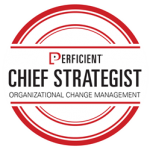Digital transformation causes disruption because it holistically changes an organization. It changes the way people work, a company’s essence, and how it operates. Consequently, it sometimes even changes the culture. Change management’s role is to help along the entire journey. More business leaders realize that change management needs to be incorporated in everything a company does. Furthermore, it’s best to do so from the beginning of a technology implementation. You can’t start change management work too soon, but you can start it too late.
In all, projects that employ effective change management strategies are six times more likely to be successful than those that do not, according to Prosci.
3 Actions to Take Now:
1. Prepare Your Employees
Prepare and equip your employees for a successful transition into a new way of operating. As a result, you will have a significant advantage over competitors that do not. Up to 75 percent of a client’s project ROI depends on employees actually using the system or process they implement as intended. Ultimately, employees define project success. It’s not whether or not the new system has defects.
2. Explain the Benefits
If digital transformation is to succeed, your employees have to buy into and then adopt the change, whether it’s a new system or process. Buy-in doesn’t happen because the project team sent a company-wide email that a new process is coming. Employees have to choose to buy in on their own. They have to see the benefits – to the company and to them. Once they do, you can start down the path of culture change, tactical change, or process change. All of this to make digital transformation a reality.
3. Emphasize the Experience
If you don’t think strategically about your people, they become “doers.” They’re along for the ride. Give employees an experience that’s not only going to make your organization better but also present new challenges and growth opportunities.
How Change Management Dramatically Reduced Migration Incidents
Our client Oshkosh Corporation needed to transition more than 10,000 global employees, across five business segments, from IBM Lotus Notes email and Sametime messaging systems to an on premises Microsoft Exchange and Skype for Business solution.
OshKosh’s help desk anticipated a 20- to 30-percent incident rate, but our organizational change management (OCM) efforts reduced that to less than 5 percent. Working with the client, our OCM consultants led the development and execution of a readiness strategy. This strategy enabled a smooth transition for the users while establishing a standard for excellence in change management.
We developed a robust OCM strategy that enabled a strong global change champion network to help execute the strategy. This strategy included global communications, key stakeholder engagement, and end-user training plans. We developed a training curriculum that incorporated a variety of methods including instructor-led super user training; customized, multilingual end-user eLearning modules, and quick reference guides.
Want More Digital Transformation Advice?
My insights for this blog post draw from Perficient’s e-book, “How to Make Digital Transformation Gains in 2019.” In it, my fellow Perficient Chief Strategists and I share real-world examples from conversations with today’s leading brands at various stages of digital transformation. Our 10-chapter e-book features our business insights, actions to take now, and client success stories. Download it here or via the form below.
Stay Tuned
This blog series is part of a special series inspired by our e-book. In the next post, my fellow Chief Strategist Mike Rabbior will show you how to find your competitive advantage.
Subscribe to our Digital Transformation weekly digest here to get the blog posts automatically delivered to your inbox every week. Or, follow our Digital Transformation blog for this series and advice on the topic from all of our thought leaders.
 About the Author
About the Author
David Chapman serves as General Manager and Chief Strategist for Perficient’s Organizational Change Management practice. He has more than 20 years of management consulting experience, specializing in the change management discipline. David brings his unique insight to the people aspects of any change from technology implementations to broader strategic organizational imperatives.


I like what you said about explaining the benefits of change to help manage it with your employees. My boss wants to make some changes in the company, and he wants to make sure that they aren’t too disruptive. I’ll share this information with him for his consideration.